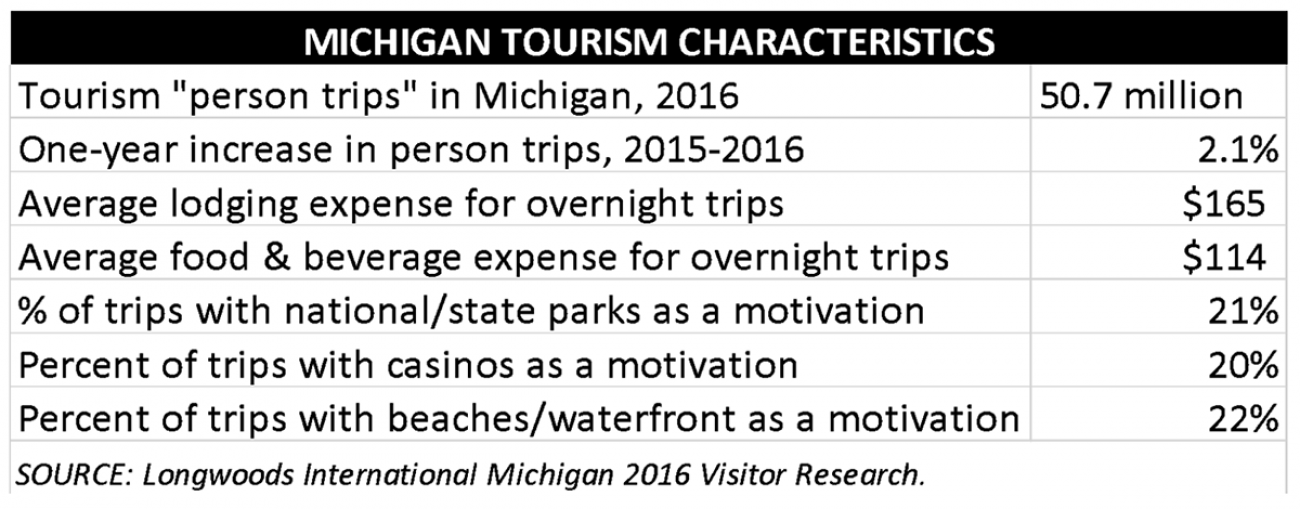Does state make $8.33 for every $1 spent on Pure Michigan campaign?

The Pure Michigan slogan is everywhere — on license plates, freeway signs, billboards, clothing and social media. It’s a brand as synonymous with Michigan as Vernors and Kellogg’s. Its ads, featuring sweeping panoramic views of lakes and trees and the voice of Detroit-raised actor Tim Allen, have even inspired parody videos.
But Pure Michigan as we know it today almost didn’t exist.
The advertising agency hired to develop the campaign initially pitched the slogan “Find Your True North.” Travel Michigan, the state’s tourism division, rejected the idea because they thought it might send the message to visitors that the state favored its northern destinations. After brainstorming words like “water” and “purity,” the agency, McCann Detroit, came up with “Pure Michigan.”
As it enters its second decade, the campaign has become a flashpoint for critics who say its success is evaluated based on flawed assumptions about its return on investment. Bridge Magazine found it impossible to independently assess Pure Michigan’s ROI, since neither the state nor the company hired to produce the data would provide direct access to the methodology.

Where Michigan Tourism Stands Today
Michigan’s tourism economy as measured by Gross State Product – including arts, recreation, hotel accommodations and restaurants and bars – was approximately $14.2 billion in 2016, according to U.S. Bureau of Labor Statistics data. That’s up $1.8 billion (or 15 percent) from the low point of the Great Recession in 2010.
The tourism industry reported to Bridge Magazine a brisk 2017, including increases in hotel occupancy and average daily rates, meetings and conventions, leisure travel, state park campground use, and Mackinac Bridge crossings.
The Pure Michigan Controversy
Pure Michigan has an annual budget of $35 million, only part of which goes to the TV and radio ads. The Michigan Economic Development Corp. has adopted the slogan for use in its business attraction marketing.
The state hired Toronto-based Longwoods International to evaluate the Pure Michigan campaign, including its return on investment. Longwoods’ research found that the ads were responsible for generating millions of trips and more than $1 billion in visitor spending in 2016. The company’s analysis said state spending of $12.9 million on Pure Michigan advertising in 2016 led to $107.3 million in new state tax revenue, or $8.33 for every dollar spent.
But neither Longwoods nor Travel Michigan would release full access to how the company calculates ROI; the company said its methodology is proprietary.
Related coverage from our 2018 Michigan Issue Guide
- Michigan's Great Lakes are good, but water concerns include lead and Line 5
- Michigan battling 22 invasive forest species, high electric bills
Travel Michigan said the company asked visitors if they saw a Pure Michigan ad and whether it prompted their trip. The company controlled for “internal and external factors,” but those factors were not disclosed. That makes it difficult, if not impossible, to independently verify the results.
The Midland-based Mackinac Center for Public Policy, a free-market think tank, has criticized the state and Longwoods for the ROI findings. The Mackinac Center claims the figures are too high to be believable, and the MEDC — which houses Travel Michigan — has a conflict of interest in seeking the data because it manages the program being studied and would have an incentive to want positive results.
Travel Michigan in 2017 parted ways with Longwoods and signed a new deal with Indianapolis-based Strategic Marketing and Research Insights. The state said the change was more about gaining new marketing insights on the campaign and less about the ROI criticism.
In addition, concerns about the brand’s viability were raised after the lead-poisoning water crisis in Flint, given Michigan’s image as home to pristine freshwaters.
What’s the future of Pure Michigan?
Travel Michigan leaders say the Pure Michigan campaign will have to adapt as the tourism industry adjusts to the ways technology is disrupting where vacationers stay and how they plan their trips, specifically among millennials and users of the sharing economy. And the state is using more digital and social media marketing in the campaign. But there are no immediate plans to end or change the award-winning advertisements.
KEEP DIGGING: MORE INFORMATION ON TOURISM & PURE MICHIGAN
- Bridge Magazine: “State: Pure Michigan Brings in More than $1 Billion. Skeptics: Prove It”
- Bridge Magazine: “As Economy Improves, So Does Michigan Tourism”
- Archive of Pure Michigan Ads
- Longwoods International: 2016 ROI Analysis of Pure Michigan Campaign
- Mackinac Center: “Pure Michigan A Poor Investment”
Explore the Facts & Issues Guide:
At A Glance
Slideshows…
Education & Talent
- K-12 Student Performance: Michigan's K-12 performance dropping at alarming rate
- School Reform: Many Michigan K-12 reform ideas are jumbled, broad, or wildly expensive
- Early Childhood: Michigan preschool funding has improved, but child care still unaffordable
- Higher Ed: College funding cuts in Michigan have led to fewer students, greater debt
Economy & Prosperity
- Economy: Michigan business climate improves, but educated workforce is shrinking
- Jobs & Labor: Demand for Michigan workers is very high, but many have given up looking
- Incomes: Michigan income growth hindered by lack of college graduates
- Business: Business incentives cost Michigan millions, and it’s uncertain they work
Quality of Life
- Public Health: Michigan's adverse health trends track along racal, poverty lines
- Health Care: Health care in rural Michigan communities suffering, despite Obamacare
- Safety Net: $1B of Michigan’s welfare money goes to college students who aren’t poor
- Water Issues: Michigan's Great Lakes are good, but water concerns include lead and Line 5
- Lands & Energy: Michigan battling 22 invasive forest species, high electric bills
- Michigan Tourism: Does state make $8.33 for every $1 spent on Pure Michigan campaign?
- Infrastructure: Michigan needs $4B more per year for infrastructure, but how to pay for it?
- Cities: In Michigan, more than 150 communities are financially distressed
- Rural Michigan: Limited Internet in rural Michigan depresses student, business opportunity
- Public Safety: Michigan pays 18% less per citizen than nat'l average for public safety
Government & Reform
- Michigan Taxes: Michigan gives more tax breaks than it collects for schools, government
- State Spending: Big government? Michigan's state, local workforce 2nd smallest in nation
- Ballot Issues: 2018 Michigan ballot initiatives may decide marijuana, gerrymandering
- Gov't Reform: Despite low trust of gov't, Michigan legislators have done little to change
Who We Are & The Facts on Our Facts
See what new members are saying about why they donated to Bridge Michigan:
- “In order for this information to be accurate and unbiased it must be underwritten by its readers, not by special interests.” - Larry S.
- “Not many other media sources report on the topics Bridge does.” - Susan B.
- “Your journalism is outstanding and rare these days.” - Mark S.
If you want to ensure the future of nonpartisan, nonprofit Michigan journalism, please become a member today. You, too, will be asked why you donated and maybe we'll feature your quote next time!

